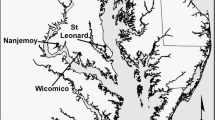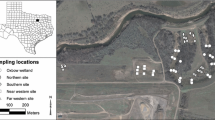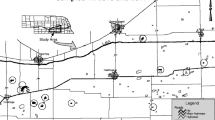Abstract
Wetlands maintain biodiversity and provide numerous ecosystem services, so the pressure to perform successful restoration consequently is high. However, restoration projects rarely include an in-depth assessment of wetland potential for recovery, and restoration techniques may not be tailored to site-specific concerns. This study examined the seed bank of disturbed wetlands slotted for hydrologic, but not vegetation, restoration to determine if a seed bank comparable to that of nearby undisturbed wetlands persisted despite long-term anthropogenic disturbance. We compared the aboveground vegetation and seed bank compositions under drained, drawdown, and flooded conditions between undisturbed and historically ditched (“disturbed”) wetlands. Disturbed and undisturbed wetlands shared fewer than 30 % of total aboveground species. While undisturbed wetlands were dominated by graminoids, disturbed wetlands had greater cover of forbs. The seed banks of disturbed wetlands had high species diversity, but their composition was dissimilar to that of nearby undisturbed wetlands. In total, the seed banks of both disturbance histories germinated 56 species; drained conditions had the fewest germinants while flooded conditions had the most. Germinant richness was significantly affected by disturbance, moisture, and their interaction; evenness was significantly affected by moisture, and Shannon diversity by disturbance. Because the seed bank of disturbed wetlands included many fast-growing wetland plants, passive vegetation restoration and active hydrologic restoration may result in wetlands overgrown with weedy species and with fewer conservative wetland plants. An understanding of the capacity for seed banks to re-vegetate wetlands post-restoration and approximate undisturbed wetlands is crucial to the overall success of restoration projects.




Similar content being viewed by others
References
Abrahamson WG, Johnson AF, Layne JN, Peroni PA (1984) Vegetation of Archbold Station, Florida: an example of the southern Lake Wales Ridge. Florida Sci 47:209–250
Baskin CC, Baskin JM (2001) Seeds: ecology, biogeography, and evolution of dormancy and germination. Academic Press, San Diego
Bigwood DW, Inouye DW (1988) Spatial pattern analysis of seed banks: an improved method and optimized sampling. Ecology 69:497–507
Boughton EH, Quintana-Ascencio PF, Bohlen PJ, Jenkins DG, Pickert R (2010) Land-use and isolation interact to affect wetland plant assemblages. Ecography 33:461–470
Boughton EH, Quintana-Ascencio PF, Bohlen PJ (2011) Refuge effects of Juncus effusus in grazed, subtropical wetland plant communities. Plant Ecol 212:451–460
Boughton EH, Bohlen PJ, Steele C (2013) Season of fire and nutrient enrichment affect plant community dynamics in subtropical semi-natural grassland released from agriculture. Biol Conserv 158:239–247
Capon SJ, Brock MA (2006) Flooding, soil seed bank dynamics and vegetation resiliance of a hydrologically variable desert floodplain. Freshw Biol 51:206–223
Christman SP, Judd WS (1990) Notes on plants endemic to Florida scrub. Florida Sci 53:52–73
Cohen MJ, Carstenn S, Lane CR (2004) Floristic quality indices for biotic assessment of depressional marsh conditions in Florida. Ecol Appl 14:784–794
Costanza R, d’Arge R, de Groot R, Farber S, Grasso S, Hannon B, Limburg K, Naeem S, O’Neill RV, Paruelo J, Raskin RG, Sutton S, van de Belt M (1997) The value of the world’s ecosystem services and natural capital. Nature 387:253–260
Craft C, Reader J, Sacco JN, Broome SW (1999) Twenty-five years of ecosystem development of constructed Spartina alterniflora (Loisel) marshes. Ecol Appl 9:1405–1419
FNAI Florida Natural Areas Inventory (2010) Guide to the natural communities of Florida: 2010 edition. Florida Natural Areas Inventory (FNAI), Tallahassee
Gerritsen J, Greening HS (1989) Marsh seed bank of the Okefenokee Swamp: effects of hydrologic regime and nutrients. Ecology 70:750–763
Hamman ST, Hawkes CV (2013) Biogeochemical and microbial legacies of non-native grasses can affect restoration success. Restor Ecol 21:58–66
Hill MO, Bunce RGH, Shaw MW (1975) Indicator species analysis, a divisive polythetic method of classificiation, and its application to a survey of Native Pinewoods in Scotland. J Ecol 63:597–613
Hopfensperger KN (2007) A review of similarity between seed banks and standing vegetation across ecosystems. Oikos 116:1438–1448
King DM, Bohlen CC (1994) Making sense of wetland restoration costs. University of Maryland Center for Environmental and Estuarine Studies Chesapeake Biological Laboratory, Solomons, p 12
Landman GB, Menges ES (1999) Dynamics of woody bayhead invasion into seasonal ponds in South Central Florida. Castanea 64:130–137
Leck MA, Brock MA (2008) Ecological and evolutionary trends in wetland seed banks: evidence from seeds and seed banks in New South Wales, Australia and New Jersey, USA. Plant Species Biol 15:97–112
Lohrer FE (2007) Archbold biological station fact sheet. http://www.archbold-station.org/station/html/aboutus/factsht.html. Accessed 20 June 2012
McCorry MJ, Renou F (2003) Ecology and management of Juncus effusus (soft rush) on cutaway ponds, Forest Ecosystem Research Group, Department of Environmental Resource Management
Menges ES, Marks PL (2008) Fire and Flood: why are South-central Florida Seasonal Ponds Treeless? The American Midland Naturalist 159:8–20
Mitsch WJ, Wilson RF (1996) Improving the success of wetland creation and restoration with know-how, time, and self-design. Ecol Appl 6:77–83
Mitsch WJ, Wu X, Nairn RW, Weihe PE, Wang N, Deal R, Boucher CE (1998) Creating and restoring wetlands. Bioscience 48:1019–1027
Navarra JJ, Quintana-Ascencio PF (2012) Spatial pattern and composition of the Florida scrub seed bank and vegetation along an anthropogenic disturbance gradient. Appl Veg Sci
Reiss KC (2006) Florida wetland condition index for depressional forested wetlands. Ecol Ind 6:337–352
Streever B, Zedler J, Mitsch WJ, Wu XB, Nairn RW, Want N (2000) To plant or not to plant. Bioscience 50:188–189
Swain H, Rothermel B (2012) Excerpts from draft of reserve management
Team RDC (2011) R: a language and environment for statistical computing. R Foundation for Statistical Computing, Vienna
Tessema ZK, Boer WFd, Baars RMT, Prins HHT (2012) Influence of grazing on soil seed banks determines the restoration potential of aboveground vegetation in semi-arid savanna of Ethiopia. Biotropica 44:211–219
USDA, United States Department of Agriculture (2012) FY 2011 acres enrolled and contracts data. Natural Resources Conservation Service, Washington, DC
van der Valk AG, Verhoeven JTA (1988) Potential role of seed banks and understory species in restoring quaking fens from floating forests. Vegetatio 73:3–13
van der Valk AG, Bremholm TL, Gordon E (1999) The restoration of sedge meadows: seed viability, seed germination requirements, and seedling growth of Carex species. Wetlands 19:756–764
Weekley CW, Lindon HH, Menges ES (2006) Archbold biological station plant list. http://www.archbold-station.org/station/html/datapub/species/lists/plantsintro.html. Accessed 20 June 2012
Wetzel PR, van der Valk AG, Toth LA (2001) Restoration of wetland vegetation on the Kissimmee River floodplain: potential role of seed banks. Wetlands 21:189–198
Wienhold CE, van der Valk AG (1989) The impact of duration of drainage on the seed bank of norther prairie wetlands. Can J Bot 67:1878–1884
Wunderlin RP, Hansen BF (2003) Guide to the vascular plants of Florida, 2nd edn. University Press of Florida, Gainsville
Wunderlin RP, Hansen BF (2008) Atlas of Florida vascular plants, Institute for Systematic Botany University of South Florida, Tampa, Florida, USA
Acknowledgments
We would like to thank Archbold Biological Station for opportunity and funds to conduct this research. We would especially like to acknowledge Carl Weekley and the other members of Archbold Biological Station’s Plant Ecology Program, who provided countless days of scientific support throughout this study. Additionally, we would like to thank Carl Weekley, Richard Marinos, Betsie Rothermel, and an anonymous reviewer for reviewing this manuscript.
Author information
Authors and Affiliations
Corresponding author
Rights and permissions
About this article
Cite this article
Ficken, C.D., Menges, E. Seasonal wetlands on the Lake Wales Ridge, Florida: does a relict seed bank persist despite long term disturbance?. Wetlands Ecol Manage 21, 373–385 (2013). https://doi.org/10.1007/s11273-013-9308-4
Received:
Accepted:
Published:
Issue Date:
DOI: https://doi.org/10.1007/s11273-013-9308-4




